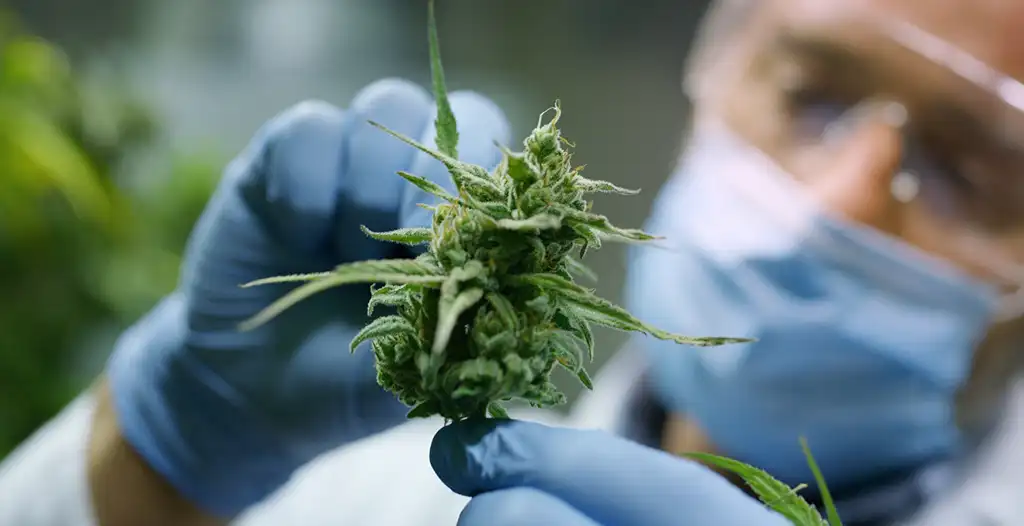The flower of Cannabis Sativa L. is incredibly complex containing hundreds of chemicals which have the potential to interact with the human body, including over 140 cannabinoids. These cannabinoids, alongside other compounds such as terpenoids, contribute significantly to the distinctive aroma and flavouring of the plant.
The most prominent compounds in cannabis flower are the so-called major cannabinoids. This is the name given to cannabidiol (CBD) and Δ9-tetrahydrocannabinol (THC) as they are found in the highest concentration within cannabis flower. In addition, they are the two compounds about which we know the most from a scientific point of view on how they affect the human body.
Other cannabinoids that are present in lower quantities in cannabis are widely known as “minor” cannabinoids. These include, but are not limited to:
- Cannabichromene (CBC)
- Cannabidivarin (CBDV)
- Cannabigerol (CBG)
- Cannabinol (CBN)
- Tetrahydrocannabivarin (THCV)
The term cannabinoid, unlike most chemical classes, is used to refer to their ability to interact with cannabinoid receptors and instead cannabinoids are actually a diverse group of chemical compounds. The cannabinoid receptors are one of the primary components of the endocannabinoid system, which has a role in regulating nerve signalling and inflammation.
Whilst all cannabinoids interact with the endocannabinoid system, not all are capable of producing the noted euphoria that may be reported by people consuming sufficient amounts of Δ9-THC. The authors of a recent study set out to determine if any minor cannabinoids or terpenoids also possess the potential to cause these effects. They employed a study design to assess minor cannabinoids and terpens for Δ9-THC-like psychoactivity in mouse model and determine their binding affinities at CB1 and CB2 receptors.
Design and Methods of the Study
Several cannabinoids and terpenoids were examined in this study, namely Δ9-THC, CBD, CBN, CBC, cannabichromenevarin (CBCV), Δ8-tetrahydrocannabinol (Δ8-THC), (6aR,9R)-Δ10-tetrahydrocannabinol [(6aR,9R)-Δ10-THC], Δ9-tetrahydrocannabivarin (THCV), β-caryophyllene, and β-caryophyllene oxide.
Binding Affinity Determination
Human embryonic kidney cells (HEK293) which expressed either human CB1 or CB2 receptors, were grown in appropriate media with antibiotics. These cells were then homogenised and suspended in a membrane buffer. Receptor binding was determined using a luminescence counter.
Drug Discrimination Procedure
Male and female mice were trained to respond to one of the two nose-poke apertures in operant chambers following intraperitoneal injection of the Δ9-THC training dose (5.6 mg/kg) and to respond on the other aperture following vehicle administration according to a fixed ratio schedule of food reinforcement, under which 10 consecutive responses on the correct (injection-appropriate) aperture resulted in delivery of a food pellet. Prior to each daily training session, mice received a single injection of Δ9-THC or vehicle in a double alternation schedule.
When these criteria had been met for the most recent Δ9-THC training dose and vehicle sessions and 8 of the 10 most recent sessions, reliable discrimination had been established, then stimulus substitution testing began.
Dose-effect curves for each minor cannabinoid or terpene were determined in subsets of mice from the overall group. Furthermore, THCV was tested in combination with the 5.6 mg/kg training dose of Δ9-THC to evaluate possible antagonism and 30 mg/kg of each terpene (β-caryophyllene and β-caryophyllene oxide) was tested in combination with various doses of Δ9-THC to assess possible synergism.
Results of the Study
Binding Affinity
CB1 receptor affinities ranged across the minor cannabinoids, with THCV having the highest affinity and CBC having the lowest for the receptor. Most minor cannabinoids showed measurable CB1 receptor binding, and affinities for three (CBC, CBCV, and CBD) exceeding 1 μM. There was also variance in the affinities for the CB2 receptor, although the range was narrower. β-caryophyllene and β-caryophyllene oxide exhibited very low affinity for both CB1 and CB2.
Drug Discrimination Results
As expected, Δ9-THC fully and dose-dependently substituted for the 5.6 mg/kg training dose. Statistically significant increases in response rates were observed at doses of 1, 3, and 5.6 mg/kg and decreases were observed at 10 mg/kg, each as compared to vehicle, although the magnitude of these changes was small. Similarly, Δ8-THC also produced full dose-dependent substitution for the 5.6 mg/kg training dose of Δ9-THC, but was less potent than Δ9-THC in both sexes. Response rates were also significantly decreased at 30 mg/kg Δ8-THC.
CBN (tested in both sexes) and (6aR,9R)-Δ10-THC (tested only in males) also increased responding on the Δ9-THC-associated aperture; however, maximal percentage of responses ranged from 50 to 75% and occurred only at the 100 mg/kg dose of each compound. Overall response rates were significantly decreased at this dose for CBN and (6aR,9R)-Δ10-THC.
In contrast, CBD, CBC, and CBCV produced minimal responding on the Δ9-THC-associated aperture across all doses in males and females. None of these minor cannabinoids significantly affected overall response rates in either sex.
THCV did not affect substitution of the 5.6 mg/kg Δ9-THC training dose in either sex, but response rates were slightly increased by the combination of 30 mg/kg THCV and 5.6 mg/kg Δ9-THC.
When tested alone, both terpenes (β-caryophyllene and β-caryophyllene oxide) produced minimal substitution (maximum of 14%). Response rates were not significantly affected by Δ9-THC nor by doses of up to 30 mg/kg of the terpenes. When Δ9-THC was tested in combination with 30 mg/kg β-caryophyllene or β-caryophyllene oxide, full dose-dependent substitution occurred.
Conclusions
The results of the present study confirm previous research showing that the strength of binding to cannabinoid receptors varies between different cannabinoids. Furthermore, of the seven cannabinoids and two terpenes assessed in this study, only three (Δ8-THC, (6aR,9R)-Δ10-THC, and CBN) produced Δ9-THC-like discriminative stimulus effects. This suggests that the use of these three cannabinoids in humans would likely be associated with similar psychoactive effects to Δ9-THC. Evaluation of THCV and the two terpenoids in combination with Δ9-THC in this model suggested that none of these compounds would alter the effects of Δ9-THC.
These results are crucial for helping to further understand the effects of different cannabinoids and terpenoids. This can hopefully help guide future research into the medical uses and safety of minor cannabinoids and terpenes.





